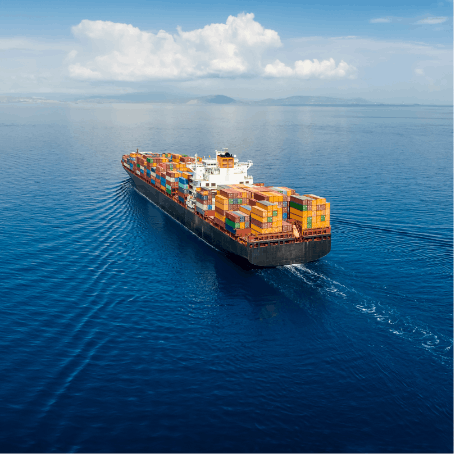Reliability of global supply chains has a direct impact on business performance for shippers. Timely arrival of goods is vital to maintaining supply levels for every industry. Unexpected delays are most acutely felt in industries that ship vulnerable goods such as pharmaceuticals or perishable items. But for any business that relies on just-in-time inventory management, special events or promotional activity, unexpected delays can have a negative impact on their bottom line and ability to compete, not to mention their relationships with customers.
A lack of transparency
According to the International Chamber of Shipping, 90% percent of world trade is carried out through ships[1]. With the average global schedule reliability of container shipping for some trades as low as 50%[2], delays have a negative economic impact not only on individual shippers, but on global economic productivity. While delays can’t be entirely prevented in container shipping, proactive notification of delays would enable shippers and their consignees to prepare for the “unexpected” by making alternative operational plans.Since the arrival of digitalisation, some carriers or third parties have been able to provide additional data to shippers (and their freight forwarders) regarding ETA, or revised dates of arrival. However, in many cases, the data quality is questionable due to the lack of a common language across carriers, or even within a carrier. Also, the mechanism for informing customers of changes is often impractical, requiring shippers to search for the latest ETA on multiple carrier web portals. This is not only costly and time consuming for the shipper, it is virtually impossible for companies that ship thousands or more TEUs per year.Building standards for visibilityDigitalisation within a single carrier’s operation can improve on the above scenario to a certain extent for shipments that are confined to a single mode and carrier, but many shipments are executed across multiple carriers and modes of transport[3]. Currently, container shipping as a whole lacks a common approach to technology and common definitions for data and processes, making information exchange between parties difficult.Having a common data language and framework for processes based on shared requirements is the first step to ensuring that high-quality data can be communicated in a way that is understandable and usable for any stakeholder in the supply chain regardless of carrier, choice of technology platforms, or even the mode of transportation.Digital Container Shipping Association (DCSA) works in close conjunction with our ocean carrier members, industry stakeholders, solutions providers, industry regulators and other standards bodies to develop open-source standards that can be freely adopted by all to provide seamless, uninterrupted and automatic (if desired) communication of shipping data. Specifically in the areas of Track & Trace and Internet of Things (IoT), our standards drive maximal visibility from end to end, enabling shippers to receive updates regarding the whereabouts of containers and the status of their contents at any point along the container journey.Can we get that in real-time?A key component of visibility is the timeliness of the data. Can shippers get the information they need in time to avoid disruption? There are methods of digitalisation, such as EDI, that enable data to be exchanged electronically, but only one-way and in batch. To provide the level of agility and responsiveness shippers need, digital data communication protocols must be developed using APIs.APIs enable 2-way, real-time data exchange which benefits everyone involved in a transaction, particularly in terms of exception handling. With APIs, shippers can query a carrier’s system or subscribe to automatically receive status updates for any relevant event. If there are delays or other types of exceptions, shippers can learn about them as they happen and work to resolve them immediately. DCSA standards are published with API definitions and design principles to ensure robust, real-time communication that can scale to meet global industry demands now and in the future.Next steps? Adoption, adoption, adoptionDigital transformation in highly standardised industries such as banking and telecommunications didn’t happen overnight, but it did happen decades ago. This contributed to their ability to weather the COVID pandemic without disrupting global operations. While disruptions along the physical supply chain due to COVID (such as factory closures) were unavoidable, the impact on container shipping could have been diminished if the industry was more digitalised and standardised. Container transportation can be more resilient if (API-based) digital standards such as those published by DCSA are widely implemented by carriers, solution providers and other participants in the supply chain.Shippers who wish to have more reliable shipping services must start by working with their carriers and service providers to adopt standards that will create a foundation for timely exception handling, driven by reliable, real-time data that is consistent across carriers. With these standards in place, shippers can have instant access to the information they need to make informed, data-driven decisions about inventory management, helping establish trust between all stakeholders. Once trust through transparency is established, real innovation can occur—innovation that will enable transparent, reliable, easy to use, secure and environmentally friendly container transportation services.Sources: [1] https://www.ics-shipping.org/wp-content/uploads/2014/08/shipping-world-trade-and-the-reduction-of-co2-emissions-min.pdf [2] SeaIntel Maritime Analysis, Global Liner Report July 2019 as summarized by Verband der Chemischen Industrie (VCI) [3] https://www.bts.gov/topics/freight-transportation/freight-shipments-mode
Digitalise the container shipping industry
At DCSA, we envisage a digitally interconnected container shipping industry in which customers have a choice of seamless, easy-to-use services that provide the flexibility to meet their business and sustainability goals.





